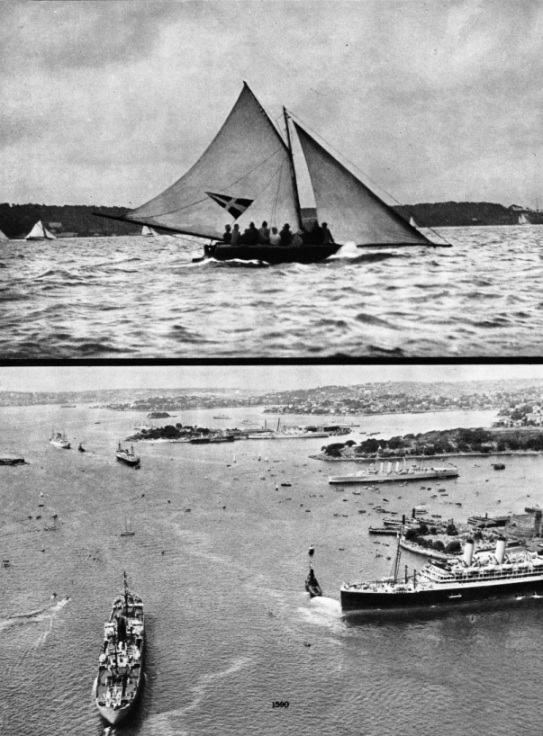
© Shipping Wonders of the World 2012-



Part 50
Part 50 of Shipping Wonders of the World was published on Tuesday 19th January 1937.
It included a centre photogravure supplement illustrating Sydney Harbour. It formed part of the article on Sydney’s Magnificent Harbour.
The Cover
This week’s cover was painted by Claude Muncaster specially for Shipping Wonders of the World. It shows the Olivebank, in which Mr Muncaster served, and is after a drawing he made on the spot, sitting out on the end of the jib-boom as the ship was coming up through the tropics. The Olivebank is one of Erikson’s ships and is a steel four-masted barque of 2,795 tons gross.
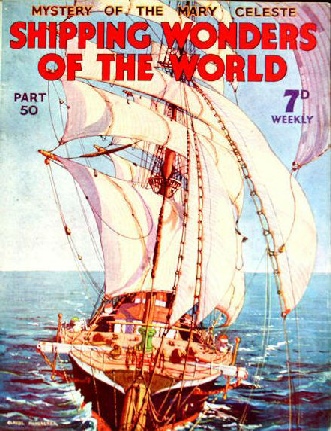
Contents of Part 50
Modern Ocean Raiders
The story of armed German merchantmen and certain independent cruisers such as the Dresden during the war of 1914-18. This chapter is concluded from part 49.
Privateering
Once a legalized form of sea-roving and raiding, a voyage in a privateer offered a seafaring life full of adventure and excitement, with enormous profits for those who were successful. Some confusion often exists between the terms “pirate” and “privateer”. A pirate is in the same class as a bandit or thief, but a privateer was a man who had authority to roam the seas subject to certain conditions. This chapter gives an enthralling account of the romance of privateering. The article contains accounts of many famous exploits and tells of the deeds of such men as Dampier, Woodes Rogers and Alexander Selkirk.
Sydney’s Magnificent Harbour
Extending inland for 13 miles, Sydney’s famous harbour claims to be the finest in the world. So broken is the foreshore that the total length of water frontage is 188 miles, which permits of facilities for yachting as well as for commerce. The citizens of Sydney are rightly proud of their wonderful harbour and the magnificent bridge which spans it. The harbour runs inland for about 13 miles and has a total water area of some 22 square miles. The famous bridge was opened in 1932. This chapter is further illustrated by four pages in photogravure and other pictures. The article is the fifteenth the series on Great Ports of the World.
Sydney’s Magnificent Harbour
(photogravure supplement)
Sydney Cove
SYDNEY COVE, seen from the bridge, incorporates Circular Quay, which has been famous since the days of sail. Nine berths are now in existence, with a total length of 3,574 feet, and a depth of water alongside of between 26 and 31 feet. Most of the town’s ferry traffic is concentrated in Circular Quay, and even since the opening of the bridge more than 20,000,000 passengers are carried each year. In 1788 Governor Phillip had his convict ships brought round from Botany Bay and anchored up the cove, which, in those days, ran much farther inland than the present Circular Quay. In this photograph the P and O liner Narkunda (16,632 tons gross) is seen being taken from her berth by a tug, while ferry steamers ply to and from Circular Quay.
Mystery of the Mary Celeste
Of all the unsolved mysteries of the sea, none has excited such interest and speculation as the fate of the Mary Celeste, which was found in December 1872 under full sail and in perfect order, but without a soul on board. The strange circumstances in which the derelict was found by the Dei Gratia have caught the imagination of countless lovers of the sea and have caused endless speculation as to what really happened. The story has inspired writers, too, and many authors have offered solutions to the mystery - solutions which agree in varying degrees of accuracy with the established facts. This chapter contains a concise and lucid statement of the known facts.
Naval Intelligence
The extraordinary success of the Naval Intelligence Division of the British Admiralty during the war of 1914-18 has never been fully disclosed, but it is known to have given the Allies many important advantages. Napoleon I once said that the issue of battles and the fate of empires would be determined “if one could only see what is happening on the other side of the hill”. Undoubtedly the greatest single factor in warfare is the element of surprise, and for this reason all nations have their own intelligence departments to probe into the secret movements of other nations.
This is the thirteenth article in the series The Navy Goes to Work.
The Italian Navy
During the war of 1914-18 the Italian Navy did not feature in any major action but distinguished itself by outstanding feats of a dashing nature. The present fleet has been built almost entirely since the war, and is one of the most powerful modern fleets in existence. One of the most dramatic feats of the war of 1914-18 was the sinking of the Austrian battleship Szent Istvan by a tiny Italian motor-boat. This was typical of the dashing exploits of the Italian fleet during the war of 1914-18. The Italian fleet lost many ships, however, and was much depleted by the end of the war. Thus the Italian Navy as we know it is essentially a product of the post-war age. This chapter is the fourth article in the series on Fleets of the Foreign Powers.
Cable Ships at Work
The history of cable ships begins with the laying of the first successful cable between England and France in the middle of the last century. Despite tremendous opposition and heavy misfortune, the laying of the Atlantic cable began a new era in world communications. This is the second chapter on the work of the cable ships, the earlier article being on Laying the Ocean Cables The Great Eastern is sometimes referred to as the first cable-laying ship, but the first ship to be permanently fitted out for the laying of cables was the Monarch. The article is concluded in part 51.
You can read about the first Atlantic cable in Wonders of World Engineering.
Sydney’s Magnificent Harbour: Photogravure Supplement
AN ORIENT LINER berthed in Woolloomooloo Bay, which is separated from the heart of Sydney by the Domain, Hyde park, and other open spaces. Fourteen berths for ships are available, with an aggregate length of 6,188 feet, and the depth at low tide is between 30 and 35 feet. The main jetty is 1,140 feet long and 208 feet wide, with a covered concrete roadway down the centre. Five of the fifteen large cargo sheds are double-decked and fitted with electric cargo-handling cranes. The foreshore of this bay is the only one that has not been preserved from encroachments on the part of industrial or commercial enterprise.
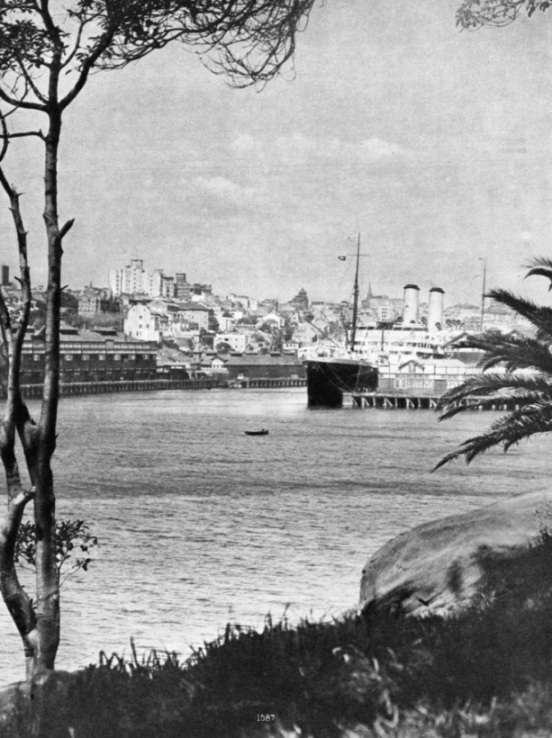
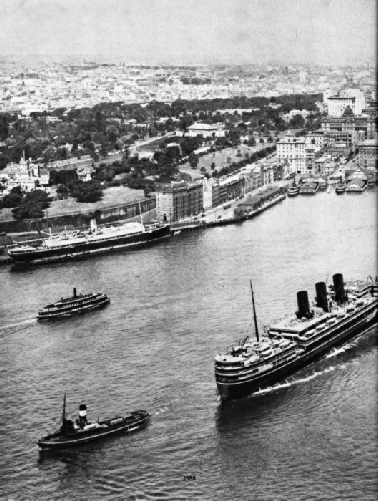
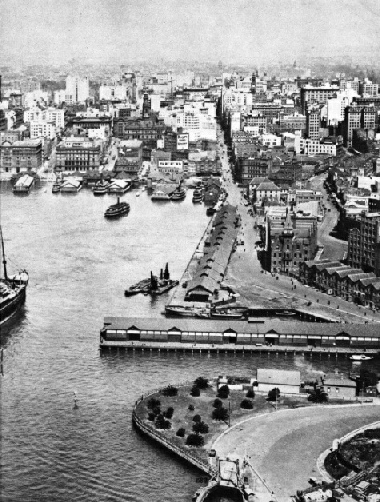
Sydney’s Magnificent Harbour - 3
THE SMOOTH WATER of Sydney harbour, with its innumerable coves and bays, makes possible wonderful yachting. The spread of sail carried by some of the racing yachts is tremendous, and the crews act as shifting ballast, leaning out to windward to prevent capsizing.
A STRIKING CONTRAST to the photograph of Sydney Cove (above) is afforded by this view of Sydney Harbour, also taken from the bridge. The natural bays and coves make the harbour an ideal pleasure resort, and small craft of all kinds mingle with warships and passenger liners.
